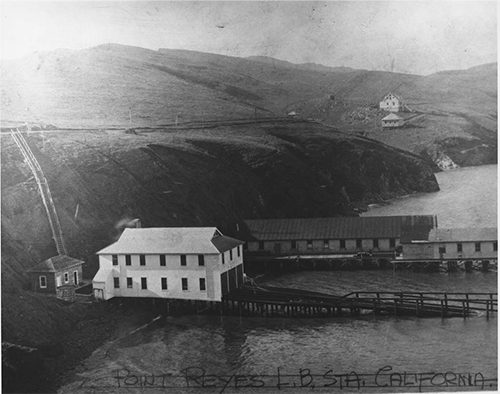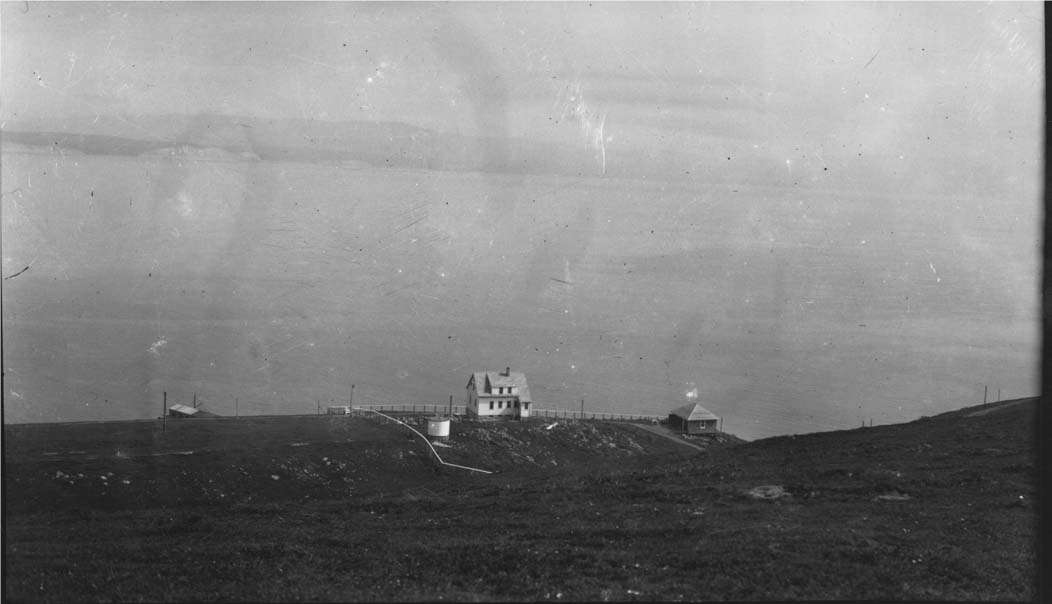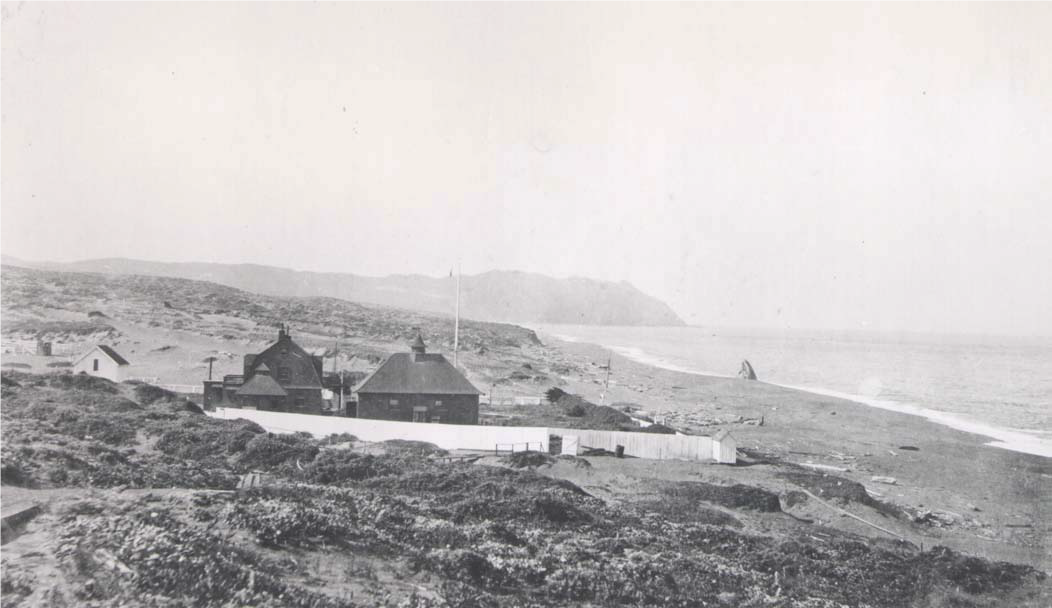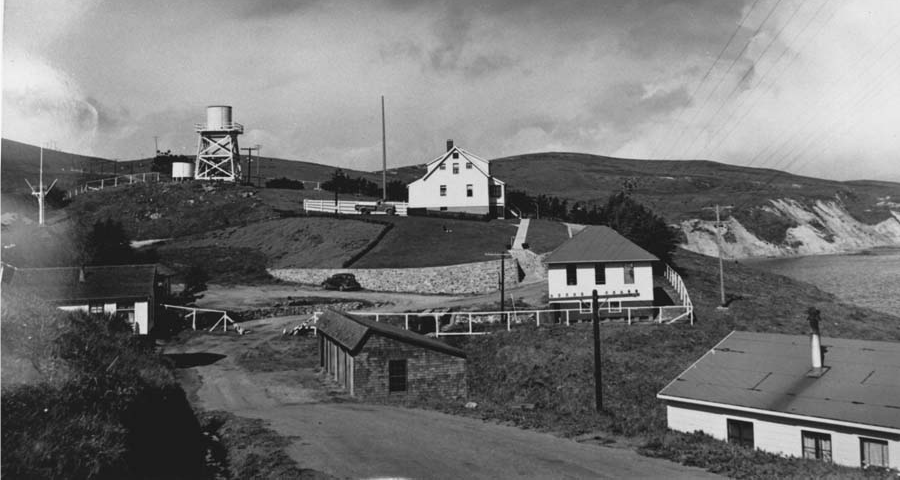Article
Remembering Maritime Life: The Point Reyes Lifeboat Station Historic District

NPS
In 1968, the property was transferred to the National Park Service and Point Reyes National Seashore, who used the lifeboat station for park housing until it was restored in 1976. As a result of further restoration to the historic district, Point Reyes possesses the only surviving lifeboat station on the Pacific Coast with an intact marine railway.
Saving Ships and Training Soldiers on the California Coast
The need for a lifesaving station at Point Reyes was recognized early in the history of California because of the numerous shipwrecks which occurred along its shores. Point Reyes juts several miles out into the Pacific Ocean. Its rocky cliffs intercept the prevailing southerly currents and are frequently hidden from view in some of the densest fog on the western coast.

NPS / Point Reyes National Seashore, Park Archives
A new Point Reyes Life-Saving Station began operation in 1927 when the U.S. Coast Guard, which had been formed in 1915 by the merger of the USLSS and the U.S. Revenue Cutter Service, completed the construction at the U.S. Coast Guard Station No. 313 on Drakes Bay at Chimney Rock. The new lifeboat station was designed by Coast Guard architect Victor Mendelheff to accommodate heavy 36-foot motorized lifeboats. It featured a three-track marine railway for launching motorized lifeboats, a gasoline-powered winch for operating the boat carriage, and dormitory-styled crew`s quarters. A second cluster of buildings, the Officer-in-Charge quarters and related outbuildings, were constructed nearby in the same year, about 1000 feet west of the lifeboat house at the top of the hillside overlooking the bay.

NPS / Point Reyes National Seashore, Park Archives
The Officer-in-Charge quarters stood at the edge of grazed pastureland, owned at that time by Azorean dairyman Joseph V. Mendoza. Numerous fishing operations developed in the Lifeboat Station area, including the Paladini wharf next to the lifeboat station and the F.E. Booth wharf on the shoreline directly below the Officer-in-Charge Quarters. The three groups—the U.S. Coast Guard crew, the ranchers, and the fishermen—formed a community together in this remote location, sharing resources and housing.

NPS / Point Reyes National Seashore, Park Archives
After World War I, the surrounding Lifeboat Station landscape was modified from Works Progress Authority (WPA) construction projects in the 1930s and 1940s. At the breakout of World War II in 1941, the Navy Department took emergency command of the Point Reyes Lifeboat Station area. The Lifeboat Station held as many as 50 men at one time, primarily for temporary military training and coastal beach defense patrols. Point Reyes hosted training in dive bombing, landing barge practice, and air-sea rescue. The life-saving crews were regularly called upon to rescue the young trainees who dumped their planes in the ocean or retrieve the bodies of the less fortunate pilots. Due to overcrowded conditions, the life-saving crew and Navy trainees often bunked together in homes built by guardsmen on Mendoza`s ranch or in the Paladini wharf.
Throughout its forty-one years in operation, days at the Point Reyes Lifeboat Station on Drakes Bay were occupied primarily by equipment maintenance tasks and training drills. During its first decade of operation, the station`s crew saved over $3,000,000 worth of property and assisted 45 vessels, including three major shipwrecks. Following World War II, the need for the station was reduced by improvements in maritime technology and discontinuation of the standard 36-foot lifesaving boat in 1956. Point Reyes Lifeboat Station was gradually replaced by a new lifeboat station at Bodega Bay, 20 miles north, due to its shipping port, sheltered cove, and space for the new standard 44-foot lifesaving boats. In 1968, the U.S. Coast Guard decommissioned and transferred the Lifeboat Station land to the Point Reyes National Seashore.
Preservation of Point Reyes Lifeboat Station and Lifesaving Boat

NPS
Although its use for humanitarian lifesaving services diminished in the years following 1968, the 13-acre Point Reyes Lifeboat Station Historic District was preserved when it was designated on the Historic Register of Places in 1985 and then as a National Historic Landmark in 1990. The life-saving station, officer-in-charge quarters area, and 75 acres of surrounding coastal pastoral landscape are preserved and maintained by the National Park Service. Point Reyes National Seashore currently possesses one of the original 36-foot motor lifeboats used at the Point Reyes Lifeboat Station, boat number CG-36542. The motor lifeboat was built in 1953 and served for ten years at Point Reyes until it was transferred to the Bodega Bay lifeboat station. After being deactivated by the Coast Guard, it was transferred back to Point Reyes National Seashore in 1982.
Thousands of 36-foot motor lifeboats of three different models were built between 1908 and 1956, but now fewer than a dozen survive in the United States and most are museum display vessels. The CG-36542 model of lifeboat is a rescue craft designed to remain afloat in adverse sea conditions, and it was the first standard motor-propelled lifeboat type adopted by the Coast Guard for lifesaving. To return the life-saving boat to the water, historic preservation of the lifeboat began in 1991 and restoration of marine railway followed in 2005.

NPS / PWRO
Witnessing History

NPS / PWRO
The Lifeboat Station Historic District at Point Reyes National Seashore preserves the history of the evolving need for lifesaving and defense on this part of the western coast. The importance and hard work of maritime operations were displayed on June 18, 2019, when NPS employees and volunteers gathered at the Lifeboat Station to facilitate and watch the restored lifeboat be launched into the water.
Working in the historic Lifeboat Station, which is now used as temporary housing for the NPS and as the home of the lifeboat, the team attached a winch to a boat cradle holding up the life-saving boat and four “crew members” loaded in. Using a manual box car mover, like those used to move a single railroad car, a six-person crew took turns propelling the boat forward on the flat portion of the marine railway inside the boathouse. With strength and patience, the crew maneuvered the lifeboat a few inches at a time until it was out of the lifeboat station building. Once on the sloping outdoor portion of the marine railway, gravity and the weight of the large historic life-saving boat helped to ease the boat into the water. The winch was used to bring the lifeboat back up and down the marine railway to break the kelp along the marine rail that had grown in the year since the last launch.
The launching of the restored lifeboat was a grand experience, connecting the viewer to the hard work of the humanitarian live-saving crew of the past and to the park’s dedicated work to maintain this history for the benefit of those in the present. The contemporary images presented here are from the assessments to ensure this site is maintained into the future. Today, the Point Reyes Lifeboat Station Historic District is one of many areas managed by the National Park Service as part of Point Reyes National Seashore. The park preserves the cultural and natural resources of this part of coastal California, including those related to maritime history, transportation, military expansion, and ranching.
Lifeboat Station History at Point Reyes
Shipwrecks at Point Reyes
Point Reyes Record: Then and Now: U.S. Life-Saving Service
Point Reyes Lifeboat Station Cultural Landscape Inventory report
"Coast Guard Motor Lifeboat CG 36500," Maritime History of Massachusetts
Cultural Landscapes
Tags
- point reyes national seashore
- cultural landscape
- point reyes
- pwr
- transportation
- navigation
- featured article
- life-saving station
- lifeboat station
- drakes bay
- maritime history
- world war ii
- world war i
- coast guard
- wpa project
- chimney rock
- boathouse
- point reyes beach
- uscg
- u.s. coast guard
- u.s. coast guard history
- uslss
- u.s. life-saving service
Last updated: April 7, 2023



